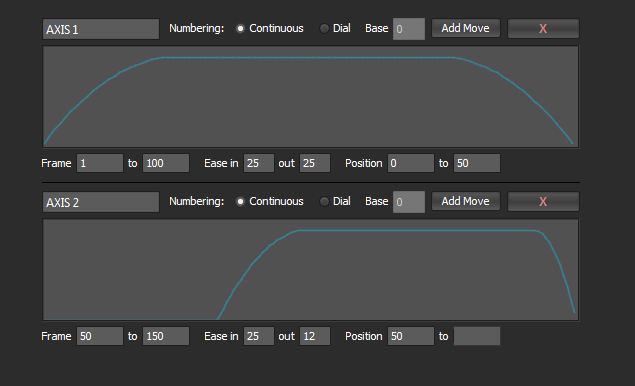Hey guys,
Hi im working ina very similar idea,,
a have a very nice acceleration and deccelleration program which works with the sparkfunks easy driver, v4.4
i found the arduino code in the old arduino forum and it works very very nice. i made also to many diferent experiments with the accelstepper library,
You could attach your variables with the following code and dont forget say thanks to C Eckert..
/*
= Project: S curve
= Language: Arduiino r12
= Date: January 2008
= Author: C. Eckert
*/
// Givens
long ta = 3e6; // acceleration time (microsec)
long td = 3e6; // decelleration time (microsec)
long Vm = 3200; // steady state velocity (pulse/sec)
long Pt = 12800; // total number of pulses for move (1600 steps per rev)
// Other variables
long dly; // stepper pulse delay (microsec)
long t = td/9; // current time (microsec) - You need to seed the initial time with something > 0
// so you don't calculate to long of a delay
long t12; // time during constant velocity (microsec)
int count = 0; // count the number of pulses
int Perr = 0; // error in position
// Arduino pins
#define dirPin 3
#define stepPin 12
void setup() {
Serial.begin(9600);
pinMode(dirPin, OUTPUT);
pinMode(stepPin, OUTPUT);
// Calculate the time at constant velocity
t12 = (Pt/(Vm/1e6))-0.5*(ta+td);
Serial.println(); Serial.println();
Serial.println("Setup Done");
}
void loop()
{
digitalWrite(dirPin, LOW); // Set the stepper direction
// Decide which part of the velocity curve your at
if (t<ta) { // Acceleration
//Serial.println ("Acceleration Curve");
dly = (ta)/(2*(Vm/1e6)t);
}
else if (t>=ta && t<(ta+t12)){ // Constant velocity
//Serial.println ("Constant Velocity");
dly = 1/(2(Vm/1e6));
}
else if (t>=(ta+t12) && t<(ta+t12+td)){ // Deceleration
//Serial.println ("Deceleration Curve");
dly = 1/(2*((Vm/1e6)-(Vm/(1e6td))(t-ta-t12)));
}
t = t+2*dly; // update the current time
//Serial.print("dly: "); Serial.print (dly); Serial.println(" microsec");
//Serial.print ("Current time: "); Serial.print(t); Serial.println(" microsec");
// Move stepper one pulse using delay just calculated
digitalWrite(stepPin, HIGH);
delayMicroseconds(dly);
digitalWrite(stepPin, LOW);
delayMicroseconds(dly);
count ++;
// The move is finished
if (t>(ta+t12+td)){
Serial.println ("Move Complete");
Serial.print ("Total steps indexed: "); Serial.println (count);
// Correct for any position error due to rounding
Perr = Pt-count;
if (Perr < 0) {
digitalWrite(dirPin, 1^digitalRead(dirPin)); // reverse the stepper direction
delay(50);
Perr = -1*Perr;
}
for (;Perr>0;){
digitalWrite(stepPin, HIGH);
delayMicroseconds(dly);
digitalWrite(stepPin, LOW);
delayMicroseconds(dly);
Perr--;
}
count=0;
t=td/9;
delay (1000);
}
}
